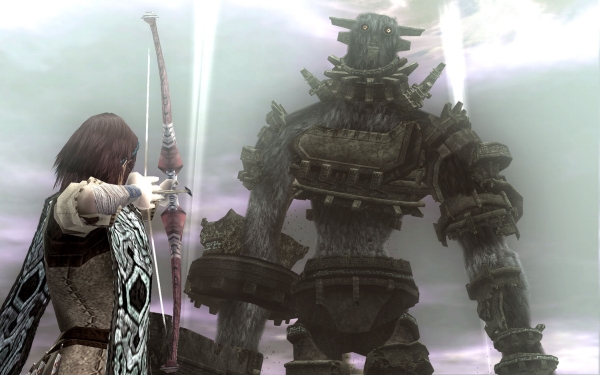
Sony recently teamed up with developer Bluepoint Games to take Shadow of the Colossus and reimagine it “from the ground up” for the PS4. As one of the first games that could truly be described as “artistic,” it holds a special place in the hearts of many gamers. But how did it get there?
Though it was critically-acclaimed from the very beginning, Ico was only a moderate hit for Sony and developer Fumito Ueda when it was released in 2001. But Ueda was thrilled with the game’s artistic ambition, and decided to create something even bigger as a followup.
 Insert Quarter is a glimpse into gaming’s past, present, and future through an exploration of historical, retrospective, and contemporary reporting.
Insert Quarter is a glimpse into gaming’s past, present, and future through an exploration of historical, retrospective, and contemporary reporting.
Shadow of the Colossus began life shortly after the release of Ico as “Nico,” a temporary codename that winkingly positioned the game as a sequel to Ico (Ueda pulled the same trick years later by initially referring to The Last Guardian as “Trico”). Shortly after Shadow of the Colossus‘s release, PlayStation Australia revealed its connection to “Nico”:
NICO, as it was then known – a play on the Japanese word for ‘two’ (‘ni’) – was demonstrated in video-only form internally, prompting plenty of excited gossip within Sony offices around the world. At PlayStation.com we distinctly remember an excited product manager enthusing about a title they’d seen at a 2003 showcase of upcoming PS2 titles that featured an ICO-esque character scaling a huge beast, and declaring that it was like nothing they had ever seen before.
NICO: the game that never was
Shadow of the Colossus quickly gained a following for its artful depiction of a barren world, and Wander’s quest to stave off a traumatic end for a loved one by toppling giant Colossi especially resonated with filmmaker Mike Binder as he was working on Reign Over Me, a film starring Adam Sandler and Don Cheadle.
The film’s editor, Jeremy Roush, eventually told the story to Kotaku‘s Brian Ashcraft:
Jeremy Roush let the game do the talking. Adam Sandler watched the plasma television as filmmaker Mike Binder looked on. They were demoing a video game for the Hollywood actor in hopes of convincing him to include it [in] the upcoming Reign Over Me, co-starring Don Cheadle. In-game save posts were far from the action, and the graphics were last gen. If Sandler didn’t bite, the game was out. “One of the hard things about showing Shadow of the Colossus is that if you are not a real game player, your first glimpse of it is that it’s blocky,” Roush, an avid Kotaku reader, tells me. “You don’t see how much artistry that’s behind it because it’s not Pixar perfect.” So he turned up the music, the aspect ratio narrowed, and Sandler saw the feet of a Colossus for the first time. The music started to crescendo, and Roush gripped the DualShock he brought from home as the game’s hero Wander climbed the giant.
The Colossus and the Comedian
Even before its endorsement by Hollywood, Shadow of the Colossus also found itself at the center of the “are video games art?” debate. Gamers furiously nodded their heads in unison, and shouted (to anyone who would listen), “Of course!” But film critic Roger Ebert disagreed. Ebert loudly railed that “video games can never be art” and pushed back against the notion that he should play games like Braid, Flower, and Shadow of the Colossus before dismissing an entire medium of expression.

Ultimately, Ebert relented in a journal entry for the Chicago Sun-Times, and said that even if he didn’t think games could be art, others did, and that was OK:
Who was I to say video games didn’t have the potential of becoming Art? Someday? There was no agreement among the thousands of posters about even one current game that was an unassailable masterpiece. Shadow of the Colossus came closest. I suppose that’s the one I should begin with.
[…]
I had to be prepared to agree that gamers can have an experience that, for them, is Art. I don’t know what they can learn about another human being that way, no matter how much they learn about Human Nature. I don’t know if they can be inspired to transcend themselves. Perhaps they can. How can I say? I may be wrong. but if ‘m not willing to play a video game to find that out, I should say so. I have books to read and movies to see. I was a fool for mentioning video games in the first place.
Okay, kids, play on my lawn
Even after everything Shadow of the Colossus did for the “games as art” discussion, it was still a game that never felt entirely at home on the PlayStation 2. Like all of Ueda’s designs, it was just a bit too ambitious. That’s why Patrick Lee of The AV Club rode along with the people trying to map the game’s hidden corners and first drafts:
Team Ico’s Shadow Of The Colossus is mired in secrets. Some of these are harmless, benign obfuscations of facts that are more interesting when left unexplained, like its characters’ motivations. But it also keeps more traditional secrets deliberately out of sight. The setting of Shadow Of The Colossus is a forbidden land, but beyond what is forbidden merely to the main character are lands forbidden even to players. It’s only thanks to the work of in-game explorers—from the earliest tinkerers like WWWArea and Pikol to Nomad’s exhaustive campaign—that we can view these normally inaccessible areas with our own eyes. These are the true secrets of Shadow Of The Colossus, the intimate secrets it genuinely attempts to hide from its players, and like all true secrets, they reveal the game’s deepest shames and compromises.
We were never meant to see Shadow Of The Colossus’ beautiful secrets
Shadow of the Colossus recently underwent a huge transformation for its PS4 debut, but fans are still enamored with the adventure at its core. Please come back next week for another look at the community’s evolving relationship with the game.
